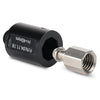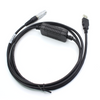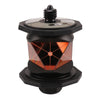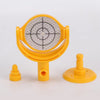The Role of 360-Degree Mini Prism in Topographic Surveying
In the world of precision topographic surveying, the 360-degree mini prism has emerged as an indispensable tool for engineering and construction professionals. This innovative optical device, designed to work seamlessly with total stations and other surveying instruments, enables comprehensive data collection from multiple angles without requiring constant repositioning. The compact yet powerful 360-degree mini prism represents a significant advancement in measurement technology, allowing surveyors to capture accurate spatial data in various environmental conditions.
Its unique cylindrical design with precision-ground glass surfaces permits reliable signal reflection from any direction, dramatically improving fieldwork efficiency. As topographic surveying continues to evolve with higher accuracy requirements, this specialized prism has become increasingly vital for projects demanding precise dimensional control and comprehensive spatial data collection.

Do 360-Degree Mini Prisms Really Work?
360° Omnidirectional Coverage
Unlike traditional single-face prisms that require precise orientation toward the total station, the 360-degree mini prism captures measurements from any angle thanks to its cylindrical glass construction. This omnidirectional capability significantly reduces setup time and eliminates measurement errors caused by improper prism orientation. Surveyors can continue working efficiently even when taking measurements from multiple positions or when the prism is temporarily obstructed from view. The continuous measurement capability ensures that topographic surveys progress without unnecessary interruptions for prism readjustment, making it particularly valuable in complex terrain where operator movement is restricted.
Precision Engineering and High Accuracy
The structural integrity and optical precision of 360-degree mini prisms ensure remarkably high measurement accuracy, with some models achieving precision levels within 1.5mm. These prisms typically utilize premium optical glass (BK7 material) with specialized metallic coatings (copper/silver) to optimize reflectivity and signal return. The precision-ground glass surfaces maintain consistent measurement accuracy regardless of the angle from which the total station signals approach. This consistent performance makes these prisms particularly valuable for topographic surveys requiring high-precision contour mapping and feature location.
Compact Design with Practical Features
The compact form factor of the 360-degree mini prism makes it exceptionally versatile for topographic surveying in confined spaces or complex environments. Many models incorporate practical features like built-in suspension threads and bottom weight attachments that enhance stability during operation. This compact design facilitates use in various challenging scenarios, including forested areas with dense vegetation, urban settings with numerous obstructions, and underground applications where space is limited. The small profile minimizes interference with natural features while providing the reflective surface needed for accurate measurements.

Enhanced Efficiency with Time Savings
The implementation of 360-degree mini prisms in topographic surveying operations substantially reduces fieldwork time by eliminating the need for constant prism reorientation. Survey crews can collect more data points in less time, increasing overall productivity while maintaining measurement integrity. This time efficiency translates directly into cost savings on topographic projects of all scales. The reduction in repetitive adjustment movements also decreases operator fatigue, leading to more consistent measurement quality throughout the workday.
Key Considerations When Selecting 360-Degree Mini Prisms
Material Quality and Optical Performance
When sourcing 360-degree mini prisms, prioritize units manufactured from premium optical glass like BK7 with high-quality metallic coatings. The quality of these materials directly impacts measurement accuracy and long-term reliability. Inferior materials may degrade over time, compromising reflectivity and introducing measurement errors.
Mounting Mechanism Compatibility
Ensure the 360-degree mini prism features standardized mounting threads (typically 1/4") compatible with your existing surveying equipment. Check compatibility with your prism poles, tribrachs, and other mounting accessories to avoid integration issues in the field. Some specialized applications may require custom mounting solutions, which reputable manufacturers can typically provide.

Environmental Durability
Topographic surveying often occurs in challenging environments, so select 360-degree mini prisms with robust construction capable of withstanding field conditions. Look for features like weather-resistant coatings, durable housing materials, and sealed components that prevent moisture ingress. The prism should maintain its optical properties despite exposure to temperature variations, humidity, and incidental impacts during transport and use.
Precision Verification and Quality Assurance
Reputable 360-degree mini prism manufacturers provide comprehensive specifications and verification testing for their products. Review accuracy certifications and test data to ensure the prism meets your project requirements. Be aware that some research has identified potential minor variations in reflection centers between different prism faces, which high-precision applications may need to consider.
Conclusion
The 360-degree mini prism stands as a transformative tool in modern topographic surveying, offering unparalleled directional flexibility, measurement precision, and operational efficiency. Its innovative design addresses the limitations of traditional single-face prisms, enabling surveyors to work more effectively across diverse applications from underground mining to detailed topographic mapping.
When selecting these optical instruments, professionals should prioritize optical quality, construction durability, and compatibility with existing equipment. As topographic surveying continues to evolve with advancing technology, the 360-degree mini prism will undoubtedly remain an essential component in the surveyor's toolkit. For projects demanding the reliability and precision of quality-engineered 360-degree mini prisms, we encourage you to contact SMTOER manufacturer to discuss our comprehensive range of models tailored to various topographic applications.




